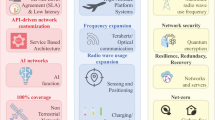Abstract
In this paper, we characterize the QoS that secondary users can expect in a cognitive radio network in the presence of primaries. To that end, we first define a \(K\)-dimensional QoS space where each point in that space characterizes the expected QoS. We show how the operating condition of the system maps to a point in the QoS space, the quality of which is given by the corresponding QoS index. To deal with the real-valued QoS space, we use vector quantization to partition the space into finite number of regions each of which is represented by one QoS index. We argue that any operating condition of the system can be mapped to one of the pre-computed QoS indices using a simple look-up in \(O(log\,N)\) time—thus avoiding any cumbersome computation for QoS evaluation. The proposed technique takes the power vector as its input from the power control unit which we consider as a black box. Using simulations, we illustrate how a \(K\)-dimensional QoS space can be constructed. We choose capacity as the QoS metrics and show what the expected capacity would be for a given power vector. We also show the effect of having large number of partitions on the distortion. As for the implementation feasibility of the proposed concept, we implement the QoS space on an 8-bit microcontroller and show how the mathematically intensive operations can be computed in a short time. Further we use binary search to achieve scalability as the dimensionality of the space increases.













Similar content being viewed by others
References
Al Tameemi, O., Chatterjee, M., & Kwiat, K. (2014). Vector quantization based QoS evaluation in cognitive radio networks. Wireless and optical communication conference, May 2014, pp. 1–6.
Spectrum Occupancy Measurements: Republican National Convention, New York City, Conducted during Aug. 30-Sept. 3, 2004. www.sharedspectrum.com/wp-content/uploads/4_NSF_NYC_Report.
Berger, R. J. (2003). Open spectrum: A path to ubiquitous connectivity. ACM Queue, 1, 3.
Haykin, S. (2005). Cognitive radio: Brain-empowered wireless communications. IEEE Journal on Selected Areas in Communications, 201–220.
Haykin, S. (2005). Cognitive radio: Brain-empowered wireless communications. IEEE Journal on Selected Areas in Communications, 23(2), 201–220.
FCC spectrum policy task force. http://www.fcc.gov/sptf.
Hoang, A. T., Liang, Y.-C., & Islam, M. H. (2010). Power control and channel allocation in cognitive radio networks with primary users’ cooperation. IEEE Transactions on Mobile Computing, 9(3), 348–360.
Lin, Y.-E., Liu, K.-H., & Hsieh, H.-Y. (2010). Design of power control protocols for spectrum sharing in cognitive radio networks: A game-theoretic perspective. IEEE ICC, 1–6.
Shi, Y., Hou, Y. T., & Zhou, H. (2009). Per-node based optimal power control for multi-hop cognitive radio networks. IEEE Transactions on Wireless Communications, 8(10), 5290–5299.
Wang, W., Peng, T., & Wang, W. (2007). Optimal power control under interference temperature constraints in cognitive radio network. IEEE WCNC, 116–120.
Zhou, P., Chang, Y., & Copeland, J. A. (2010). Learning through reinforcement for repeated power control game in cognitive radio networks. IEEE Globecom, 1–6.
Final report from the NSF Workshop on Future Directions in Wireless Networking. (2013). http://ecedha.org/docs/nsf-nets/final-report?sfvrsn=0.
Lee, D.-T. (1982). On k-nearest neighbor voronoi diagrams in the plane. IEEE Transactions on Computers, C–31(6), 478–487.
Gray, R. (1984). Vector quantization. IEEE ASSP Magazine, 1(2), 4–29.
Gersho, A., & Gary, R. M. (2012). Vector quantization and signal compression. New York: Springer.
Villmann, T., et al. (2014). Advances in self-organizing maps and learning vector quantization. New York: Springer.
Linde, Y., Buzo, A., & Gray, R.M. (1980). An algorithm for vector quantizer design. IEEE Transaction on Communications, COM-28, Jan, 84–95.
Huang, B., & Xie, L. (2010). An improved LBG algorithm for image vector quantization. IEEE ICCSIT, 6, 467–471.
Patane, G., & Russo, M. (2001). The enhanced LBG algorithm. ELSEVIER, 14(9), 1219–1237.
Veprek, P., & Bradley, A. B. (2000). An improved algorithm for vector quantization design. IEEE Signal Processing Letters, 7(9), 250–252.
Author information
Authors and Affiliations
Corresponding author
Additional information
Approved for public release; Distribution Unlimited: 88ABW-2015-0119 dated 14 Jan 2015.
A preliminary version of the paper appeared in the 23rd Wireless and Optical Communication Conference (WOCC) 2014 [1].
Rights and permissions
About this article
Cite this article
Al-Tameemi, O., Chatterjee, M. & Kwiat, K. Vector quantization based QoS evaluation in cognitive radio networks. Wireless Netw 21, 1899–1911 (2015). https://doi.org/10.1007/s11276-014-0886-8
Published:
Issue Date:
DOI: https://doi.org/10.1007/s11276-014-0886-8




